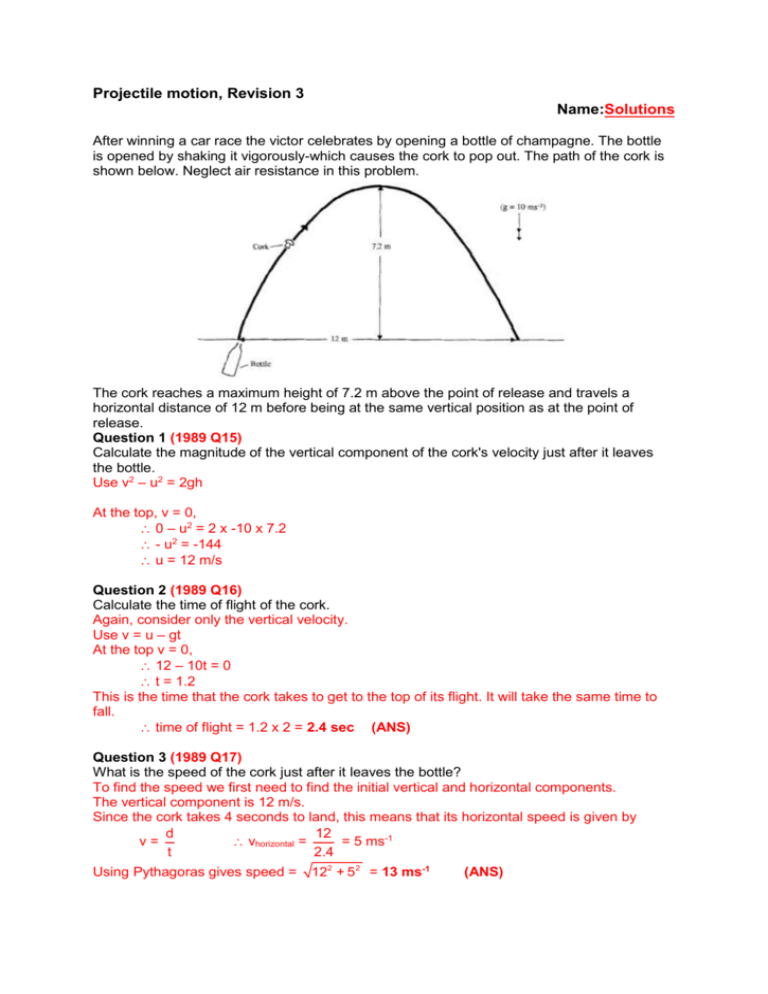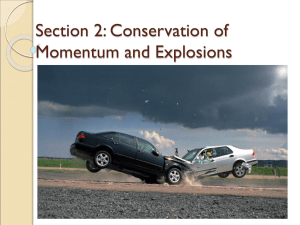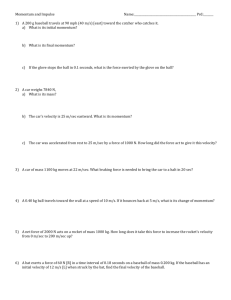3 Projectile motion revision 2015 solutions
advertisement

Projectile motion, Revision 3 Name:Solutions After winning a car race the victor celebrates by opening a bottle of champagne. The bottle is opened by shaking it vigorously-which causes the cork to pop out. The path of the cork is shown below. Neglect air resistance in this problem. The cork reaches a maximum height of 7.2 m above the point of release and travels a horizontal distance of 12 m before being at the same vertical position as at the point of release. Question 1 (1989 Q15) Calculate the magnitude of the vertical component of the cork's velocity just after it leaves the bottle. Use v2 – u2 = 2gh At the top, v = 0, 0 – u2 = 2 x -10 x 7.2 - u2 = -144 u = 12 m/s Question 2 (1989 Q16) Calculate the time of flight of the cork. Again, consider only the vertical velocity. Use v = u – gt At the top v = 0, 12 – 10t = 0 t = 1.2 This is the time that the cork takes to get to the top of its flight. It will take the same time to fall. time of flight = 1.2 x 2 = 2.4 sec (ANS) Question 3 (1989 Q17) What is the speed of the cork just after it leaves the bottle? To find the speed we first need to find the initial vertical and horizontal components. The vertical component is 12 m/s. Since the cork takes 4 seconds to land, this means that its horizontal speed is given by d 12 v= vhorizontal = = 5 ms-1 t 2.4 Using Pythagoras gives speed = 122 + 5 2 = 13 ms-1 (ANS) Mark, Rosita and Raymond are astronauts of the future, working on a moon station. Their advanced-technology space suits do not hinder their movements, so they are able to move with as much ease as they do on Earth. The acceleration due to the moon’s gravitational field near its surface is 1.60 m s-2 and there is no air resistance on the moon. Mark throws Rosita a hammer, releasing it at a height of 0.80 m as shown in the diagram below. Rosita, standing 6.0 m away, catches it at the same height, 5.0 seconds after it is thrown. Question 4 (1990 Q3) What is the vertical component of the hammer's velocity just as it leaves Mark's hand? The hammer will take 2.5 seconds to reach the top. Consider the vertical velocity only. At the top of its flight the hammer will have zero velocity in the vertical direction. Make sure you use g = 1.6 ms-2 Use v = u – gt 0 = u – 1.6 x 2.5 u = 4 ms-1 Question 5 (1990 Q4) What is the speed of the hammer when Rosita catches it? The speed when caught is the same as the speed when launched. The vertical component of the initial speed is 4 ms-1. 6 In the horizontal direction, the hammer takes 5.0 sec to travel 6 m. vhorizontal = = 1.2 ms-1 5 Using Pythagoras, gives speed = 42 + 1.22 = 4.2 ms-1 (ANS) Question 6 (1990 Q5) To what height, h, (see the diagram above), does the hammer rise? Consider the vertical motion only. At the top v = 0. Use v2 – u2 = 2gh. This give -42 = 2 x -1.6 x h h=5m (ANS) A ball is sitting on top of a high wall. Joe stands a distance away from the base of the wall and throws a stone from L in such a way that the stone is travelling horizontally at the point of impact with the ball. Ignore air resistance. The situation is shown in the figure below. The stone is released from a point level with Joe's shoulder and the ball is 7.2 m above this point. The mass of the stone is 0.10 kg and the mass of the ball is 0.30 kg. Question 7 (1991 Q7) What should be the vertical component of the velocity of the stone when it is released? Since the stone is travelling horizontally when it hits the ball, the vertical component of its velocity is zero. Consider the vertical direction only. Use v2 – u2 = 2gh u2 = 2 x 10 x 7.2 u2 = 144 u = 12 ms-1 (ANS) Question 8 (1991 Q8) If the stone hits the ball with a speed of 12 m s-1, how far is L from the wall? To solve this question we need to know how long it takes for the stone to reach the ball. This can be found from the vertical components of the initial velocity. In the vertical, use v = u – gt to get 0 = 12 – 10t t = 1.2 sec. The horizontal speed of the stone is a constant 12 ms-1, therefore the stone travels 12 x 1.2 metres in the horizontal before hitting the ball. d = 14.4 m (ANS) The stone bounces back horizontally after striking the ball and is caught at shoulder height at C, a distance 40% of the way from the wall to the point L. Question 9 (1991 Q9) What is the impulse given to the ball? The impulse given to the ball is the same as the change in momentum of the stone. The change in momentum of the stone is given by its final momentum – initial momentum. As the stone rebounds 40% of the distance, its final horizontal velocity will be 40% of its initial. The initial horizontal velocity of the ball is 12 ms-1 to the left. The final horizontal velocity of the ball is 4.8 ms-1 to the right. ∆p = 0.1 x 4.8 – (-0.1 x 12) = 0.72 kgms-1 to the right. BUT the question asks for the impulse given to the ball, 0.72 kgms-1 to the left. Question 10 (1991 Q10) What is the speed with which the ball leaves the wall? Use F∆t = m∆v = I The impulse given to the ball is 0.72 kgms-1. 0.72 = 0.3 x ∆v ∆v = 2.4 ms-1 (ANS) In an experiment, a laboratory cart carrying one brick is travelling at constant speed along a smooth level bench. Another identical brick is dropped at time T on to the cart. The mass of the cart is equal to the mass of 1.5 bricks. Question 11 (1976 Q21) Which of the graphs (A - F) below best represents the velocity of the cart as a function of time? The velocity of the cart will decrease at time T. From conservation of momentum principles, if the mass increases then the velocity must decrease. C (ANS) **Question 12 (1976 Q22) Which of the graphs (A - F) above best represents the velocity of the centre of mass of the cart and bricks? Strictly speaking, this is not on the course. The velocity of the centre of mass is constant in ALL collisions. D (ANS) Question 13 (1976 Q23) Which of the graphs (A - F) above best represents the momentum of brick X? This question is really asking what is the velocity of brick X. The velocity of Brick X will decrease when brick Y drops onto it. Since momentum is conserved, initially brick Y hasn’t any horizontal momentum, so what it gains must be lost from the initial cart-brick combination. Block Y’s vertical momentum is transferred to the earth. C (ANS) Question 14 (VCAA 1976 Question 24, 1 mark) Which of the graphs (A - F) above best represents the total energy of cart and bricks? The energy of the system does not change during the collision as there are no forces acting that will do work to change the motion D (ANS) Question 15 (1976 Q25) In a second experiment, the same cart carries three identical bricks and is travelling at a constant speed of 1.1 ms-1. A fourth brick is dropped on to the cart. What will the speed of the cart now be? Momentum is conserved pi = pf pi = (3 + 1.5)m x 1.1 = 4.95 m pf = (4 + 1.5) m x vf 5.5 mvf = 4.95 m 4.95 vf = 5.5 vf = 0.9 ms-1 (ANS) An object of mass 4.0 kg, has an initial velocity of 2.0 ms-1 north and a final velocity of 3.0 ms-1 south. Question 16 (1976 Q12) What is the magnitude of the change in momentum? Change in momentum is ALWAYS given by final – initial. In this case final momentum is 4.0 x 3.0 (south), and the initial momentum is 4.0 x 2.0 (north). change in momentum is 12 (south) – 8 (north) change in momentum is 12 - - 8 (south) the magnitude of the change in momentum is 20 kgm/s. (ANS) Question 17 (1976 Q13) What is its change in kinetic energy? Change in KE is final – initial. KEinitial = ½ mv2 = ½ x 4.0 x 22 = 8 J KEfinal = ½ mv2 = ½ x 4.0 x 32 = 18 J ∆KE = 10 J (ANS) For the object to gain energy, there must have been some work done on the object during the change in velocity process. A sphere of mass 3 kg travelling North at 2 ms-1 collides with another sphere of mass 4 kg travelling east at 2 ms-1. Question 18 (1975 Q8) The magnitude of their resultant momentum after collision will be: A zero B 2 kg m s-1 C 10 kg m s-1 D 14 kg m s-1 E dependent on whether the collision was elastic or inelastic Momentum is a vector, therefore the direction needs to be considered. From conservation of momentum, the final momentum will be the same as the initial momentum. pi = 3.0 x 2.0 (North) + 4.0 x 2 (East) pi = 10 kgm/s in a direction between North and East. (This is a 6:8:10 triangle) C (ANS) Question 19 (1975 Q9) The total kinetic energy of the two spheres after collision will be: A 10 J B 14 J C 20 J D 28 J E dependent on whether the collision was elastic or inelastic The total energy of the spheres cannot be calculated after the collision because it is not clear if the collision is elastic or not. If the collision was elastic, then the KEfinal = KEinitial, which can be calculated. If the collision is inelastic, then more information is required to calculate the final KE. E (ANS) Question 20 (1972 Q39) The area under the graph of net force versus time for an object represents A change in potential energy B acceleration C work done D power E change in momentum By definition, the area under the net force-time graph is the change in momentum, or the impulse. E (ANS)









